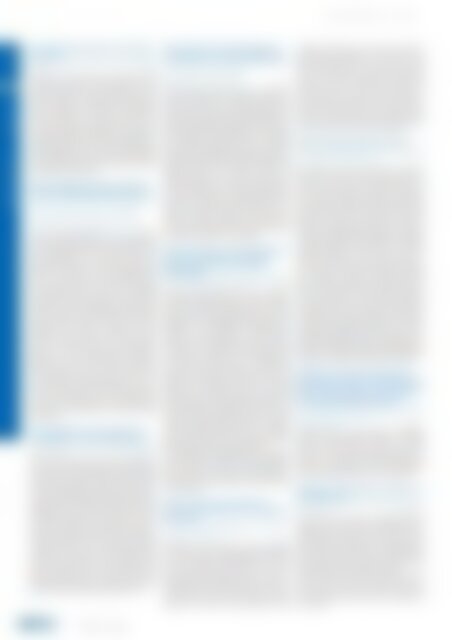Sie wollen auch ein ePaper? Erhöhen Sie die Reichweite Ihrer Titel.
YUMPU macht aus Druck-PDFs automatisch weboptimierte ePaper, die Google liebt.
<strong>atw</strong> Vol. 63 (<strong>2018</strong>) | Issue 1 ı January<br />
8<br />
ABSTRACTS | ENGLISH<br />
UK Is Leading the Way With Clear Strategy<br />
for Nuclear<br />
NucNet | Page 10<br />
The UK is Europe’s most prominent leader in nuclear<br />
development because of the government’s clear<br />
strategy of supporting nuclear energy as part of its<br />
future energy mix, a senior official from US-based<br />
nuclear equipment manufacturer Westinghouse<br />
Electric Company said. Mr Kirst told that the UK<br />
government’s decision to support the financing of<br />
new energy projects, including nuclear, by way of a<br />
contract for difference scheme was a breakthrough.<br />
Additionally potential for nuclear development in<br />
other EU member states is possible in Poland and the<br />
Czech Republic where also new nuclear capacities<br />
are possible. Potential exists also in non-EU countries<br />
like Turkey and the Ukraine.<br />
ETSON Strategic Orientations on Research<br />
Activities. ETSON Research Group Activity<br />
J.P. Van Dorsselaere, M. Barrachin, D. Millington,<br />
M. Adorni, M. Hrehor, F. Mascari, A. Schaffrath,<br />
I. Tiselj, E. Uspuras, Y. Yamamoto, D. Gumenyuk,<br />
N. Fedotova, O. Cronvall and P. Liska | Page 13<br />
In 2011, ETSON published the “Position Paper of<br />
the Technical Safety Organizations: Research Needs<br />
in Nuclear Safety for Gen 2 and Gen 3 NPPs”. This<br />
paper, published only a few months after the<br />
Fukushima- Daiichi severe accidents, presented the<br />
priorities for R&D on the main pending safety<br />
issues. It was produced by the ETSON Research<br />
Group (ERG) that has the mandate of identifying<br />
and prioritizing safety research needs, sharing<br />
information on research projects in which ETSON<br />
members are involved, defining and launching new<br />
research projects and disseminating knowledge<br />
among ETSON members. Six years after this<br />
publication, many R&D international projects<br />
finished in diverse frames, and other ones have<br />
started. In particular a lot of work was done (and is<br />
going on…) on the analysis of the Fukushima-<br />
Daiichi severe accidents. Meanwhile a roadmap on<br />
research on Gen. 2 and 3 nuclear power plants<br />
(NPP), including safety aspects, was produced by<br />
the NUGENIA association, followed by a more<br />
detailed document as “NUGENIA global vision”. It<br />
was also demonstrated that the ETSON R&D<br />
priorities were consistent with the implementation<br />
of the 2014 Euratom Directive on safety of nuclear<br />
installations.<br />
Council Regulation of the European Dual<br />
Use Regulation – A Never Ending Story?<br />
Ulrike Feldmann | Page 19<br />
For the first time, the EC Council Regulation of<br />
19 December 1994 established a Community regime<br />
for the control of exports of dual-use items. In 2000,<br />
the first major revision of the dual-use regime came<br />
into force, subjecting not only sensitive material, i.<br />
e. plutonium and highly enriched uranium, but also<br />
the entire category 0 (nuclear material, installations,<br />
equipment) to a licensing requirement for intra-<br />
Community shipments. This revision was revised a<br />
few months later due to inappropriate content by<br />
removing a small proportion of nuclear goods. A<br />
further comprehensive new revision was published<br />
in 2009. However, the EU Commission’s current<br />
proposal to revise Annex IV of the regulation does<br />
not do justice to the objective of free trade of goods<br />
and the maintenance of the competitiveness of<br />
European industry from the point of view of the<br />
European nuclear industry, as well as from the point<br />
of view of the non-nuclear industry in the EU.<br />
Nuclear Safety, Security and Safeguards:<br />
An Application of an Integrated Approach<br />
Howard Chapman, Jeremy Edwards,<br />
Joshua Fitzpatrick, Colette Grundy,<br />
Robert Rodger and Jonathan Scott | Page 21<br />
National Nuclear Laboratory has recently produced<br />
a paper regarding the integrated approach of<br />
nuclear safety, security and safeguards. The paper<br />
considered the international acknowledgement of<br />
the inter-relationships and potential benefits to be<br />
gained through improved integration of the nuclear<br />
‘3S’; Safety, Security and Safeguards. It considered<br />
that combining capabilities into one synergistic<br />
team can provide improved performance and value.<br />
This approach to integration has been adopted, and<br />
benefits realised by the National Nuclear Laboratory<br />
through creation of a Safety, Security and<br />
Safeguards team. In some instances the interface is<br />
clear and established, as is the case between safety<br />
and security in the areas of Vital Area Identification.<br />
In others the interface is developing such as the<br />
utilisation of safeguards related techniques such as<br />
nuclear material accountancy and control to<br />
enhance the security of materials. This paper looks<br />
at a practical example of the progress to date in<br />
implementing Triple S by a duty holder.<br />
Clearance of Surface-contaminated Objects<br />
from the Controlled Area of a Nuclear<br />
Facility: Application of the SUDOQU<br />
Methodology<br />
F. Russo, C. Mommaert and T. van Dillen | Page 29<br />
The lack of clearly defined surface-clearance levels in<br />
the Belgian regulation led Bel V to start a collaboration<br />
with the Dutch National Institute for Public<br />
Health and the Environment (RIVM) to evaluate the<br />
applicability of the SUDOQU methodology for the<br />
derivation of nuclide-specific surface-clearance<br />
criteria for objects released from nuclear facilities.<br />
SUDOQU is a methodology for the dose assessment<br />
of exposure to a surface-contaminated object, with<br />
the innovative assumption of a time-dependent<br />
surface activity whose evolution is influenced by<br />
removal and deposition mechanisms. In this work,<br />
calculations were performed to evaluate the annual<br />
effective dose resulting from the use of a typical<br />
office item, e.g. a bookcase. Preliminary results allow<br />
understanding the interdependencies between the<br />
model’s underlying mechanisms, and show a strong<br />
sensitivity to the main input parameters. The results<br />
were benchmarked against those from a model described<br />
in Radiation Protection 101, to investigate<br />
the impact of the model’s main assumptions. Results<br />
of the two models were in good agreement.<br />
The SUDOQU methodology appears to be a flexible<br />
and powerful tool, suitable for the proposed application.<br />
Therefore, the project will be extended to<br />
more generic study cases, to eventually develop surface-clearance<br />
levels applicable to objects leaving<br />
nuclear facilities.<br />
Carbon-14 Speciation During Anoxic<br />
Corrosion of Activated Steel in a Repository<br />
Environment<br />
E. Wieland, B.Z. Cvetkovic, D. Kunz,<br />
G. Salazar and S. Szidat | Page 34<br />
Radioactive waste contains significant amounts<br />
of 14 C which has been identified a key radionuclide<br />
in safety assessments. In Switzerland, the 14 C inventory<br />
of a cement-based repository for low- and<br />
intermediate-level radioactive waste (L/ILW) is<br />
mainly associated with activated steel (~85 %). 14 C<br />
is produced by 14 N activation in steel parts exposed<br />
to thermal neutron flux in light water reactors.<br />
Release of 14 C occurs in the near field of a deep<br />
geological repository due to anoxic corrosion of<br />
activated steel. Although the 14 C inventory of the<br />
L/ILW repository and the sources of 14 C are well<br />
known, the formation of 14 C species during steel<br />
corrosion is only poorly understood. The aim of the<br />
present study was to identify and quantify the<br />
14 C-bearing carbon species formed during the<br />
anoxic corrosion of iron and steel and further to<br />
determine the 14C speciation in a corrosion experiment<br />
with activated steel. All experiments were<br />
conducted in conditions similar to those anticipated<br />
in the near field of a cement-based repository.<br />
Review of Fuel Safety Criteria in France<br />
Sandrine Boutin, Stephanie Graff,<br />
Aude Foucher-Taisne and Olivier Dubois | Page 38<br />
Fuel safety criteria for the first barrier, based on<br />
state-of-the-art at the time, were first defined in the<br />
1970s and came from the United States, when the<br />
French nuclear program was initiated. Since then,<br />
there has been continuous progress in knowledge<br />
and in collecting experimental results thanks to the<br />
experiments carried out by utilities and research<br />
institutes, to the operating experience, as well as to<br />
the generic R&D programs, which aim notably at<br />
improving computation methodologies, especially<br />
in Reactivity-Initiated accident and Loss-of-Coolant<br />
Accident conditions. In this context, the French<br />
utility EDF proposed new fuel safety criteria, or<br />
reviewed and completed existing safety demonstration<br />
covering the normal operating, incidental<br />
and accidental conditions of Pressurised Water<br />
Reactors. IRSN assessed EDF’s proposals and presented<br />
its conclusions to the Advisory Committee<br />
for Reactors Safety of the Nuclear Safety Authority<br />
in June 2017. This review focused on the relevance<br />
of historical limit values or parameters of fuel safety<br />
criteria and their adequacy with the state-of-the-art<br />
concerning fuel physical phenomena (e.g. Pellet-<br />
Cladding Mechanical Interaction in incidental conditions,<br />
clad embrittlement due to high temperature<br />
oxidation in accidental conditions, clad ballooning<br />
and burst during boiling crisis and fuel melting).<br />
AMNT 2017: Outstanding Know-How &<br />
Sustainable Innovations – Technical Session:<br />
Reactor Physics, Thermo and Fluid Dynamics<br />
Enhanced Safety & Operation Excellence –<br />
Focus Session: Radiation Protection<br />
Joachim Herb, Erik Baumann and<br />
Angelika Bohnstedt | Page 44<br />
Summary report on the Key Topics “Outstanding<br />
Know-How & Sustainable Innovations – Technical<br />
Session: Reactor Physics, Thermo and Fluid<br />
Dynamics” and “Enhanced Safety & Operation Excellence<br />
– Focus Session: Radiation Protection” of<br />
the 48 th Annual Meeting on Nuclear Technology<br />
(AMNT 2017) held in Berlin, 16 to 17 May 2017.<br />
‘Newcomer’ Nuclear Nation Leads Way Into<br />
New Nuclear Year<br />
John Shepherd | Page 66<br />
At the start of a new year, it is appropriate that a<br />
‘newcomer’ nuclear nation has launched work on<br />
building its first nuclear power plant. First nuclear<br />
safety-related concrete has been poured for the<br />
plant at Rooppur in Bangladesh – making the South<br />
Asia nation the first in 30 years to start building its<br />
first commercial reactor unit following the United<br />
Arab Emirates in 2012 and Belarus in 2013.<br />
Despite setbacks that nuclear has endured in recent<br />
years, there are nearly 60 reactors under construction<br />
around the world, mostly in Asia. Some<br />
447 commercial reactor units are in operation in<br />
30 countries.<br />
Abstracts | English

















